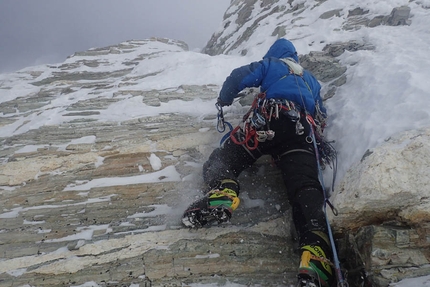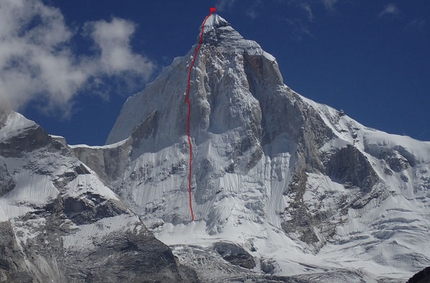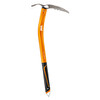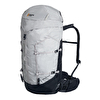Jannu East Face, Dmitry Golovchenko and Sergey Nilov complete their Unfinished Sympathy

 1 / 48
1 / 48 Dmitry Golovchenko
Dmitry Golovchenko
In mid-March Dmitry Golovchenko and Sergey Nilov embarked up the East Face of Jannu in Nepal, establishing a route which has left its mark. After the third member of their team, Poland’s Marcin Tomaszewski, opted against joining them on their undertaking, the two Russian mountaineers climbed in pure alpine style, taking 18 days in total to breach the circa 2000m high wall and then descend down the south face, unknown to them, along the mountain’s original route established in 1962 by a French expedition led by Lionel Terray.
Struggling against poor weather, on the upper section of the climb Golovchenko and Nilov wisely decided to proceed towards the ridge instead of gunning directly for the summit via the steep headwall. Low on food, the descent provoed arduous and required a full 6 days, while towards the end they were met by the support team led by the Poland’s Eliza Kubarska who in the meantime had quickly moved to the other side of the mountain. The new route is called Unfinished Sympathy, is 2500m long with a height gain of 1950m, and has been graded ED.
It goes without saying that Golovchenko and Nilov form part of Russia’s mountaineering elite, and twice previously the importance of their ascents have been recognised with a Piolet d'Or: for the difficult new route up the North Face of Thalay Sagar (6904m) in the Indian Himalaya established with Dmitry Grigoriev in September 2016, and for the 17 days in August 2012 spent with Alexander Lange breaching the unclimbed NE Ridge of Muztagh Tower (7284 m) in Pakistan. Here's what Golovchenko had to say about their Unfinished Sympathy
Jannu East Face, alpine style new route. Where did the idea for this come from? And before starting up the mountain, was it a dream or sometimes even a nightmare?
We first saw this wall in 2015. The Ukrainians Nikita Balabanov and Mikhail Fomin climbed their super-impressive line on Talung and had a very good view on East Face of Jannu. Misha shared some pictures with me and we thought it could be a nice goal for us. In spring 2016 we tried to find the money necessary for climbing Jannu but failed. This year we succeeded. Was it a dream or nightmare? No, neither. I mean, we definitely wanted to climb this face, but we never went crazy because of it.
You had difficulties right from the start, just reaching the base of the mountain proved difficult with a 100km walk…
Actually it was not too difficult to walk in, but we wanted to reach Base Camp as soon as possible, so that is why we were a bit stressed during the trek. Our schedule was very tough and we worried that we would not have enough time to acclimatise properly. So in the end we had to skip the acclimatisation phase...
The initial project involved three climbers, you two with expert Polish mountaineer Marcin Tomaszewski, who then chose not to climb. When Marcin decided not to join you, how did things change?
We reached Base Camp much later than we planned. Also, the actual approach to the mountain takes time, since you need to climb and fix 300 meters of rocky terrain, so we quickly realised that we would not have sufficient time for acclimatisation. On the evening when Marcin informed us about his decision, we didn't discuss what we would do, we just silently went to sleep. But when we woke up the next morning, Sergey and I looked at each other and said: "Go? Yes, we go!"
Surely climbing a wall of this dimension as a team of two becomes much more difficult and complicated?
Yes, you're fully right: 2 member teams or 3 member teams on such wall really make the difference! If there are 2 people only, you each have to carry more, the leader has to haul one of the bags instead of resting after each pitch and the two of you have to do all the jobs: build ledges for the tent, prepare food and drinks etc.
Tell us about the objective dangers on this mountain? In retrospect, would you make the same decisions?
Generally speaking I think route was quite safe. The only problematic place was the icefall, as it becomes dangerous after snowfall. But we crossed it when the weather was good, so we didn't have any problems there. Later, when we were higher on the face, the icefall became dangerous and this was the main reason why we decided to descend down the other side of the mountain. And we both think we took good decisions during the ascent, so no, we wouldn't change anything.
How did the ascent go? What did you expect and what surprised you?
As mentioned the icefall was difficult to pass, but we more or less expected that. What surprised us was the steepness of the upper wall. After the icefall the terrain is around 60 degrees, but higher up it steepens and becomes up to 80+ degrees close to the ridge! But Sergey managed to free climb all of this. No aid climbing at all!
So what was the most difficult thing about the climb?
The most difficult part was getting close to the ridge, after 7000 meters. The wall was very steep there, but there was still a lot of snow. You start digging in this snow, and it’s kind of granulated, so you need to dig deeper to find ice. But then in turns out that ice is also very loose, like cheese. So it is very hard to find good protection.
At one point you chose not to climb via the direct, original line to the summit, but instead continue along the ramp towards the ridge. How difficult was this decision and when did you realise that you wouldn’t reach the summit this time?
It was clear more or less from the outset that it is impossible to climb the headwall as a team of just two. That is why we took less rock gear and fewer ropes. Nevertheless we still hoped that we’d find our line through the headwall, but it would have to be relatively easy, and we knew that the chances of this were not very high. So when we saw that there was no way we'd manage to climb headwall, we easily switched to our second variation as we were already geared up for that.
On the evening before we reached the ridge (the 27th of March) we had this discussion, do we go for the summit or not. We were quite slow, the weather wasn't very good, we’d already spent almost two weeks on the mountain, we did not know how long the descent would take us. Bearing all this in mind, we decided not to go towards the summit. And now we both agree it was very much the right decision.
You actually celebrated your birthday that day. Tell us about this particular moment!
In truth it was nothing special, a day similar to the one before and the one after. We were still on the wall and it was already the 2nd or 3rd day when we woke up in the morning convinced that "we will definitely climb to the ridge today". And also we had the conversation about the summit that day.
You mentioned the dangerous icefall, how this changed condition during your ascent. So when did you realise that you were not going to descend along the ascent route, but instead proceed down the south side, along the original route up the mountain, which you did not know?
On the 3rd or 4th day of our ascent it started to snow, so the icefall became dangerous. We saw that pretty well, as the were a lot of avalanches falling through it. The decision was very simple: we had to descend via the French route, since this was safe.
Was this a sort of escape upwards towards salvation?
No, I wouldn't say that. We had this option even before the expedition.
You were on the mountain for 18 days; how much food did you take?
We expected to return in around 2 weeks, so we took food accordingly. Twice a day we had a hot meal (either French dehydrated food that Eliza kindly gave us, or 2 packs of Chinese noodles). In addition we had same dried fruit, nuts, yak cheese and some super-spicy dry yak meat!
Much has been said about the length of the expedition, but were you ever in difficulty?
We experienced the biggest difficulties during the descent. We were very tired already and the weather didn’t help us. There was a lot of snow everywhere, so even on the flat sections we had to work hard. And somehow we expected we would descend in 2 days. So when at the end of second day we were still very far away from the Yamatari glacier, we were very disappointed, but nevertheless we were sure that the next day we'd finally descend! The next day though was the same. And the next day, too. So in the end we spent 6 days descending, mostly through awful weather. We were out of any drinks for a week. We had enough gas, but we had forgotten to take the vitamins we had planned on drinking during the day, so when we finished our tea during the first week, we started to drink boiled dry apricots. But these soon finished, so we switched to raisins, but these also finished during the first couple of days of our descent. The we found some candies in our medicine box, but they finished too, and in the end we just drunk pure boiled water. I kept dreaming about warm water with vitamins inside...
Tell us about the Polish support team led by Kubarska, who moved under the south face of the mountain to coordinate the descent.
They were wonderful! We didn't expect such care for us! We were met by 4 people: director Eliza Kubarska, sound recorder Zofia Morus, our sherpa-guide Pasang and one sherpa-porter, a really strong guy! We had daily radio connection with Eliza, so they knew how we were progressing during the ascent they were also the first people who knew that we planned to descend via the original route. For us it was very helpful to have first radio contact with them, to hear other voices and to know that there were people waiting for us. Later, when we met, it was something that you really cannot describe!
How do you judge your climb now? There is no summit, true, but there is a new route and the first traverse of the mountain, all in alpine style. And of course, you are both back safe and sound.
We think we did the maximum we could given the conditions and time limits that we had, and this is why we are satisfied!
What were the examples you had when you were younger, that helped you chose your form of mountaineering?
In the beginning we climbed a lot in the Caucasus during the winter season. Until 2010 or 2011 I actaully had completed more winter ascents than summer climbs. And I really think this helped us a lot!
So what is your idea of mountaineering? Or rather, what must an ascent have for you to consider it an achievement?
Be fair with yourself and the mountain, do what you can, do not take pity of yourself - and will get what you deserve! An achievement is when you make something new on a beautiful mountain.
Your perfect route. For your perfect mountaineering.
Four necessary conditions: a beautiful mountain, and the route should be obvious, safe and difficult.
What did these 18 days on Jannu teach you?
My biggest lesson is that this is huge mountain! A monster! You think you will reach a given point today or tomorrow, but in fact it takes you 3 or 4 days…



 Copia link
Copia link



















 See all photos
See all photos



























